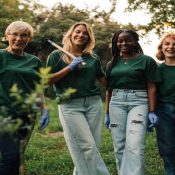
Votes for Women CT: Can We Redefine Leadership Potential?
Leadership by Women Empowerment is a living legacy that is grounded on centuries of organizing, advocacy, and civic courage. Votes for Women CT carries this heritage by shedding light on the lives of women whose perseverance changed communities and policy in Connecticut (and beyond). History consists not of a record–of a blueprint. Analyzing the methods by which suffragists formed alliances, capitalized on local networks and developed the will of the people, readers can see definite road maps to get involved in change today. Being aware of who was leading, how they were leading, and why the strategies they used were successful makes people take civic life with a purpose.
Inclusive Narratives, Stronger Movements
Women leadership is an intersectional story that is wide and diverse. Votes for Women CT features the voices that are typically marginalized in mainstream histories: Black suffragists who overcame two oppressions, immigrant organizers who have created mutual aid networks, Indigenous leaders who tended land and culture, and LGBTQ+ activists who broadened notions of equity. Empowering Women in Leadership succeeds whereby leadership is inclusive of the entirety. Representative storytelling fixes the historical narrative and fortifies current movements by making sure that strategies are attentive, reflective, and sustainable.
From Education to Engagement
Involvement is triggered by education. With the help of research-based blogs and available articles, Votes for Women CT could relate the past achievements to modern challenges-representation and leadership, access to healthcare, equity in education, and economic stability and civil rights. In every piece, there is an action associated with context, a recommendation of what a reader can do: go to a town meeting, explore a historic site, mentor an upcoming leader, or take part in a local policy discussion. Empowering Women Leadership is not a farfetched idea when people know about the past and feel welcomed to the present.
From Story to Action: Turning Insight into Impact
Leadership as a Practice, Not a Title
The Leadership of Women is empowered by the fact that one can learn leadership. It resembles listening profoundly, working across boundaries, working with integrity in conflict, and creating sustainable coalitions. Votes for Women CT brings to the fore the most common entry points, such as serving on a committee, planning a neighborhood event, assisting with an archival research, or policy brief amplification. The organization demystifies leadership to reduce the barriers to allow more individuals to be involved meaningfully and sustainably.
Historic Sites as Living Classrooms
The place brings history home. Still life lessons are transformed into stewardship life when one is standing at a courthouse where the speeches of suffrage once resounded or when one is reading a letter of a local organizer. These lessons bring about responsibility: had others struggled to get these rights in this land, we can defend and grow them now. Votes for Women CT highlights historic sites and archives in order to engage the reader with the place where change got established, and curiosity was turned into commitment and memory into action.
Building Sustainable Movements
Movements are ecosystems. They are dependent on researchers, educators, artists, storytellers, strategists, volunteers, legislators and voters. Votes for Women CT builds up this ecosystem strategy, as it demands the readers to seek functions according to their stronghold. Collective leadership, clarity of structures, mentorship, and learning are all sources of sustainability. Based on the lessons of suffrage, local organizing, sustained outreach, strategic media, and matching them with the current tools, digital engagement, information-driven policy, intersectional frameworks, the current advocates can design efforts that are both agile and sustainable.
Practical Steps You Can Take Today
Begin with the local, small-scale, and then develop:
Read a biography: choose a historical figure and read a biography about him or her or a landmark that has been related to the history of women.
Participate in a discussion: go to a school board, council or committee meeting to learn about matters and procedures.
Mentor and be mentee: transfer experience to younger leaders and ask the old ones to mentor you.
Prepare with wisdom: combine passion with preparation- be familiar with the data, the stakeholders, and the points of decision.
Each step compounds. The Leadership of Women Empowerment increases when there is a steady influx of people, who work together freely, and remain focused on equity and the well-being of the community. Policy victories are only one way of gauging progress, as do being among, access, and civic health.
Carrying the Legacy Forward
Votes For Women CT creates a bridge between the past and the present to enable the reader to create the future. The organization converts inspiration to impact through the combination of inspirational storytelling and practical advice. When individuals identify themselves in the story of change-and see themselves having definite roles to play, movements become rich, diversified, and stable. It is an invitation to know the history, to be a part of the process and be a leader in your own place. The second book of Empowering Women Leadership is already written in the neighborhoods, classes, offices and councils throughout Connecticut and it wants to hear you.
FAQs
Q1: What does Empowering Women’s Leadership look like in everyday life?
It appears to be available education, participatory decision-making, and stable civic engagement- being on a committee, attending a public forum, coordinating community activities, training new followers, and advocating for policies that promote equity. It is not leadership that is held but exercised.
Q2: How can I support Votes for Women CT right now?
Read articles and stories, explore historic sites, share your resources with your network, volunteer with community organizations, mentor future leaders, go to public meetings, and support fair policies. Every move, big or small move, lends momentum to the movement and builds up leadership of communities.




